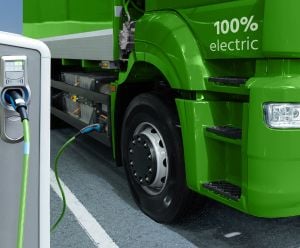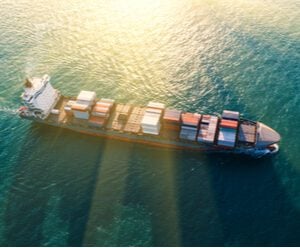
Sustainable shipping with DHL

Sustainable Shipping Options
The World Economic Forum forecasts that the current growth in last-mile deliveries will increase global carbon emissions by 30 percent by 20301. Yet, there are steps your business can take to minimize its negative impact on the environment.
Partner with a sustainable logistics carrier
In DHL’s Global Online Shopper Survey 2023, 64 percent of European consumers said sustainable deliveries are important to them, whilst DHL is seen as the most sustainable of all the leading international delivery companies. So, for a greener final mile, you know who to speak to!
With DHL Express, you will have access to a range of dedicated insetting and offsetting solutions (which we will explore further on.) Offering your customers such delivery options at checkout will reflect well on your brand and drive loyalty.
Evaluate your packaging processes
Getting your goods to your customers without damage should be a priority, but so should reducing “empty” space. Products shipped to customers in excessively large boxes are a waste of materials, not to mention the extra shipping costs incurred.
Instead, ensure your items are packed in correctly sized boxes, or design the packaging yourself according to your products’ unique specifications. Using less packaging is also a marketing opportunity – for example, a sticker with “Now with 10 percent less packaging” on the box will reflect well on your brand.
The packaging material you select is also important. Compostable mailing bags, recycled cardboard, mushroom-based containers…there are all sorts of weird and wonderful innovations out there that are less detrimental to the planet than plastic. Discover all, here.
Take steps towards carbon offsetting and insetting
Every business has a carbon footprint, which is the total amount of greenhouse gases emitted directly or indirectly by its activities. Carbon offsetting involves “balancing out” these emissions by funding carbon reduction projects outside the sector of impact. Examples include reforestation and conservation projects, investment in renewable energy infrastructure, and providing clean water to disadvantaged communities.
Meanwhile, carbon insetting is when businesses invest in carbon reduction schemes within their own supply chains. Examples include a clothing manufacturer planting trees outside its factory, a restaurant growing its own vegetables (to reduce the emissions of the supplier delivering them), or a business switching to sustainable fuel (which we explore more, further.)
Offer sustainable returns
It is estimated that up to 30 percent of all products ordered online are returned to the sender3. Whilst that is a big hit for your business’s profits, the extra shipping emissions are not good for the environment, either. But – there is a way to make the process more sustainable.
Reverse logistics promotes the recycling, repurposing, repairing, and resale of products, with the aim of extending their lifecycle. It means fewer goods end up in landfills, and, with 67 percent of consumers checking an online retailer’s return policy before committing to a purchase4, could win you some valuable extra sales. Our dedicated reverse logistics guide will help you create your own strategy.
Benefits of Sustainable Logistics
Investing in a sustainable logistics strategy can help your business in many ways…
Enhance your brand’s reputation
Consumers are increasingly concerned with sustainability and are drawn to brands that align with their values. In fact, 88 percent of consumers will be more loyal to a company that supports social or environmental issues5. Establishing clear sustainability goals for your business – and being transparent about them on your website – will resonate well with prospects.
Improve your business’s efficiency
A sustainable logistics strategy focuses on reducing waste and optimizing processes – which means your output will be more efficient. For example, by adopting route optimization software, you can cut down the time your delivery fleet spends on the road. This means no excess mileage and lower fuel consumption – reducing both emissions and costs.
Save money
Whilst some sustainable logistics strategies require upfront investment, the savings they generate in the long term make them worthwhile. A report by McKinsey6 found a positive correlation between a company’s Green Supply Chain Management practices (greenhouse emissions, recycling, waste, and renewable energy) and its profitability. This is because green logistics increases efficiencies and reduces waste – both of which impact a business’s costs.
Sustainable Shipping with DHL
It is no secret that the transport and logistics industry is a large contributor to global emissions. So, in 2017, DHL became the first logistics company in the world to set a target of reducing its greenhouse gas emissions to net zero by 2050. As part of this commitment, it has several schemes to help its customers – businesses like yours – employ sustainable shipping strategies. These include:
Alternative fuels with DHL GoGreen Plus
DHL Express has recently launched GoGreen Plus, a dedicated solution to help businesses reduce ("inset") the carbon emissions associated with their shipments through the use of Sustainable Aviation Fuel. SAF is a biofuel that is produced from renewable sources such as vegetable oils, animal fats, waste products, and agricultural crops. SAF is specifically designed to be used as a substitute for traditional jet fuel and can reduce greenhouse gas emissions by up to 80 percent compared to fossil fuels. The service can be selected for individual shipments, making it a flexible option for SMEs and e-commerce businesses with smaller cargo loads.
Other DHL’s GoGreen solutions are dedicated to helping customers understand and reduce their carbon footprint. The carbon transparency tools allow customers to measure the impact of their operations, whilst GoGreen logistics experts can develop tailor-made recommendations for improving the carbon footprint of their supply chain – such as consolidating shipments and optimizing routes.
Electric vehicles
EVs are the future of the transportation sector, and in that area, DHL has several key achievements. It has committed to deploying 80,000 e-vehicles for last-mile deliveries by 2030 – a 60 percent electrification rate of its fleet. And it is not just on the roads – in August 2021, the company made aviation history by ordering 12 fully electric “Alice” e-cargo planes from aircraft manufacturer Eviation. All of which means customers shipping domestically or internationally with DHL will have their goods transported in the most eco-friendly way possible, with emissions reduced at every mile.
Sustainable packaging
Following research that 24 percent of the volume of an e-commerce package is empty space, DHL developed an AI-powered packaging solution to make shipments more cost-effective and environmentally friendly. “OptiCarton” combines sophisticated carton optimization algorithms with an on-demand approach to packaging within the distribution center to optimize the filling volume of boxes. This means DHL’s customers benefit from more eco-friendly shipments, with the added benefit of reduced transportation costs.
With a DHL Express Business Account, you will have access to all these industry-leading sustainable shipping solutions – and many more. Choose a greener future, below.
REFERENCES
2 - Internet Retailing, September 2022
3 & 4 – Invespcro, April 2023
6 – McKinsey & Co
This article was originally published on Discover, the small business and global logistics advice guide from DHL.
ALSO WORTH READING













 English
English